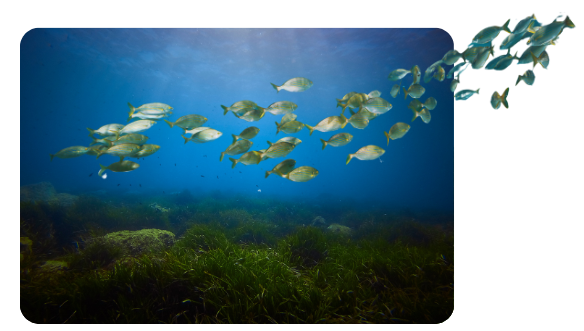Story
Understanding phytoplankton communities
14 October 2019
Understanding the structure of marine ecosystems is important for sustainable policy and management of the ocean. New research from PML looks at the structure of phytoplankton communities across the Mediterranean Sea, providing crucial insights into how these ecosystems work.

The composition of the phytoplankton community has a profound influence on the functioning of marine ecosystems, impacting ecosystem health and services, and the climate. The work focused on where different types of phytoplankton could be found, and how they influenced various fluxes of carbon in the area, by combining (or “assimilating”) satellite data with a coupled physical-biogeochemical model of the Mediterranean Sea.
It found that the Mediterranean could be divided into three different ecoregions; areas characterised by distinctive ecosystem features. One ecoregion was relatively small, with microphytoplankton (more than 20 micrometres in size) dominating a few of the most productive coastal areas. Here, the flow of food up through the food web, and of carbon into the ocean sediment, was most efficient.
Another ecoregion was larger, across lower-nutrient open waters, dominated by picophytoplankton (0.2-2 micrometres) and with the least efficient transfers of food and carbon. The final ecoregion was found in coastal and Atlantic-influenced waters, where nanophytoplankton (2-20 micrometres) were more important.
This research offers new perspectives on the variability of structure and functioning in the phytoplankton community and their related biogeochemical fluxes, adding useful information for planning ecosystem studies, as well as management and sustainable use. Such knowledge is vital for developing Blue Growth; long term strategies for supporting sustainable growth in the marine and maritime sectors.
Dr Stefano Ciavatta, PML and NCEO Senior Scientist and lead author, said: “The Mediterranean Sea is a wonderful ocean in miniature, which, however, is challenged by the activities of large populations and the impacts of climate change. We carried out this study to enhance the understanding of this ecosystem and support the sustainable use of its resources.
“We found that the Mediterranean Sea ecosystem can be subdivided in three ecoregions that are characterized by rather different phytoplankton communities, carbon fluxes and potential to sustain aquaculture and fisheries. This understanding was achieved by merging ocean-colour products of phytoplankton functional types and ecosystem model simulations, by means of “data assimilation” mathematical techniques. We are confident that our findings will support management and Blue Growth in the Mediterranean Sea.”
Related information
‘Ecoregions in the Mediterranean Sea throught the reanalysis of phytoplankton functional types and carbon fluxes‘ is published open access in Journal of Geophysical Research: Oceans
The output of the reanalysis simulation can be downloaded here: https://portal.ecosystem-modelling.pml.ac.uk
This work is the product of a collaboration across European research organisations, as well as enterprises in the aquaculture sector. It was developed in the framework of the EU H2020 TAPAS project, and had the support of the Copernicus Marine Environments Monitoring Service TOSCA and OPTIMA projects and of the UK NERC National Centre for Earth Observation (NCEO).
